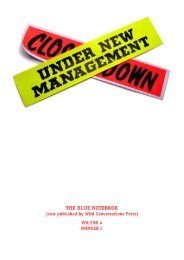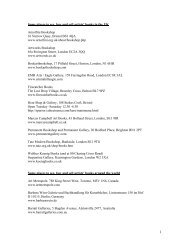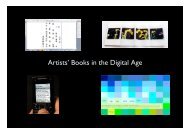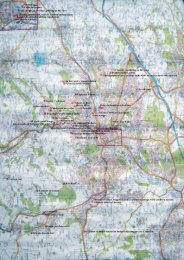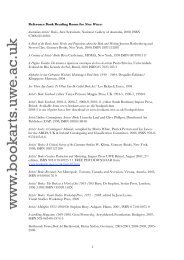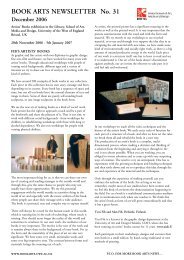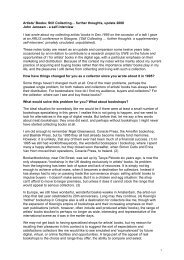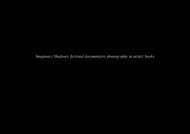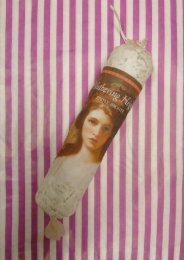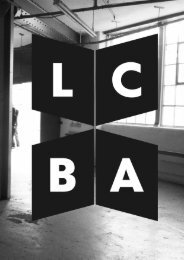Artist's Book Yearbook 2003-2005 - Book Arts - University of the ...
Artist's Book Yearbook 2003-2005 - Book Arts - University of the ...
Artist's Book Yearbook 2003-2005 - Book Arts - University of the ...
You also want an ePaper? Increase the reach of your titles
YUMPU automatically turns print PDFs into web optimized ePapers that Google loves.
Artist’s <strong>Book</strong> Reviews<br />
Andrew Eason<br />
Modern (Laundry) Production<br />
Susan Johanknecht<br />
Here’s a world where <strong>the</strong> supply <strong>of</strong> soiled linen<br />
must be consistently maintained, and where<br />
special precautions must be taken to preserve<br />
<strong>the</strong> continued “bore and flow <strong>of</strong> <strong>the</strong> dirty<br />
liquor.” Despite <strong>the</strong> vivid language, this is <strong>the</strong><br />
world <strong>of</strong> laundry.<br />
Susan Johanknecht’s Modern (Laundry)<br />
Production interposes <strong>the</strong> minute and arbitrary<br />
observations <strong>of</strong> 1940’s handbooks on<br />
industrial-scale laundry procedures, with<br />
images <strong>of</strong> a figure carrying out some arcane<br />
part <strong>of</strong> <strong>the</strong> processes described. The figure in<br />
<strong>the</strong>se repetitive, grainy images is reduced to an<br />
arm and a torso, endlessly loading linen into an<br />
unknown machine. Cut <strong>of</strong>f from <strong>the</strong>ir original<br />
contexts, both words and pictures take on <strong>the</strong><br />
qualities <strong>of</strong> poetic statement, an effect<br />
intensified by Johanknecht’s decision to<br />
organise <strong>the</strong> text into free-floating units.<br />
Language used to describe <strong>the</strong> mundane<br />
routines <strong>of</strong> sorting, washing, ironing, etc, starts<br />
to constellate deeper meanings. Some<br />
meanings resonate with body imagery, o<strong>the</strong>rs -<br />
those categorising materials and types - spark<br />
<strong>of</strong>f ruminations on <strong>the</strong> definition <strong>of</strong> material<br />
substances, and how <strong>the</strong>se definitions have<br />
been organised in many ways over <strong>the</strong><br />
centuries.<br />
This field <strong>of</strong> play is an interesting way to cast an<br />
eye over <strong>the</strong> laundress’ activities. Repetitive as<br />
<strong>the</strong>se activities are, <strong>the</strong> weave <strong>of</strong> description<br />
begins to suggest an alchemy, or a set <strong>of</strong><br />
Aristotelian transmutations that turn <strong>the</strong><br />
endless waves <strong>of</strong> cotton, silk and wool into<br />
<strong>the</strong> days and thoughts <strong>of</strong> <strong>the</strong> operator.<br />
153<br />
Turning back, though, to <strong>the</strong> descriptions in<br />
<strong>the</strong> book, <strong>the</strong>re’s still a madly-impending,<br />
Brazil-like totalitarianism to <strong>the</strong> sorts <strong>of</strong> things<br />
categorized and commented upon. In this<br />
world, <strong>the</strong> people must be <strong>the</strong> right shape for<br />
<strong>the</strong> machines, and <strong>the</strong> text bristles with words<br />
and phrases <strong>of</strong> control and subjugation.<br />
Clothing is washed in a cage, processed<br />
through a cuff and yoke press. Time itself is a<br />
commodity to be used in <strong>the</strong> most efficient way,<br />
or it is wasted time. Every action, every<br />
movement is under observation (a method <strong>of</strong><br />
control associated with 19th Century penal<br />
<strong>the</strong>ories). Calibration, observation, control are<br />
<strong>the</strong> emphasised qualities. But still, <strong>the</strong> language<br />
<strong>of</strong> <strong>the</strong> text (mostly an apparently honest lift<br />
from <strong>the</strong> 1940’s originals) is rebellious.<br />
It springs into forms that rebel against <strong>the</strong><br />
[1940’s] author’s original intention. The effort<br />
<strong>of</strong> maintaining <strong>the</strong> cyclopean rigidity <strong>of</strong> <strong>the</strong>se<br />
incantations-against-waste struggles against <strong>the</strong><br />
language’s tendency to suggest bodies, feelings,<br />
tactility. This in turn reflects back on <strong>the</strong><br />
imagery. The grainy, boring-looking pictures,<br />
each with <strong>the</strong>ir original, hand painted numbers<br />
start <strong>of</strong>f seeming identical. One notices<br />
eventually that <strong>the</strong>re is movement. This, one<br />
discovers, is a picture <strong>of</strong> one <strong>of</strong> <strong>the</strong> processes<br />
described so minutely in <strong>the</strong> text. A woman<br />
(well, an arm, actually) is feeding clothing into<br />
a calendering machine. Eventually, through <strong>the</strong><br />
repetition and <strong>the</strong> gradual drift between text<br />
and image, eventually our imagination steps<br />
out <strong>of</strong> <strong>the</strong> frame. Fills in, however sketchily,<br />
some <strong>of</strong> <strong>the</strong> gaps. Adds <strong>the</strong> missing head and<br />
limbs. Supplies <strong>the</strong> thoughts and boredom <strong>of</strong><br />
<strong>the</strong> operator, supplies <strong>the</strong> texture <strong>of</strong> <strong>the</strong><br />
clothing and <strong>the</strong> noise <strong>of</strong> <strong>the</strong> press.<br />
The last words <strong>of</strong> <strong>the</strong> text seem to turn from<br />
<strong>the</strong> voice <strong>of</strong> <strong>the</strong> machine/management to that




